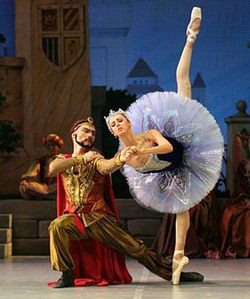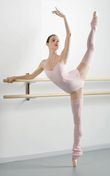
The story was written by a Russian columnist, Lydia Pashkova. Yuri Grigorivich (the Bolshoi Raymonda choreographer and the author of The Authorized Bolshoi Ballet Book of Raymonda) says of Pashkova, “[h]er works were not brilliant; they were entertaining.”I’ll try my best to summarize. The setting is a castle in medieval Hungary. A young noblewoman named Raymonda awaits the arrival of her betrothed, Jeanne de Brienne, who is off fighting in the crusades. In his absence a
Of course, there are many problems with this plot. A major issue is that it is entirely static except for the attempted abduction and the duel. Otherwise, the main conflict is a battle of desire waged within Raymonda’s own head as the erotic exoticism of the Saracen faces off against the social convention of the European nobleman. (It’s strange that I find Balanchine’s Raymonda to be so hysterical these days, for the ballet’s history is more firmly rooted in Freudian hysteria!) In her waking hours Raymonda has no real agency. But curiously, despite all the sexism, this ballet provides one of the most coveted roles for any prima ballerina. With upwards of 6 solos (depending upon the production) for the title character, Raymonda celebrates the technique and stamina of one woman above all else. So even though Raymonda seems like a passive victim in terms of plot, she is the clear victor in terms of dance.
It is the male dancers who get shortchanged in Raymonda, which is why many male dancer/choreographers (like Rudolph Nureyev and Yuri Grigorovich) have tried to remedy the plot by beefing up the male leads. In the ballet’s original incarnation, de Brienne didn’t really dance until Act III, and the Saracen was an ornamental, character role (an inherently racist one too). Balanchine, along with Alexandra Danilova, set a full-length Raymonda (based upon what they remembered of the Petipa version) for the Ballet Russe de Monte Carlo in 1946. During a fantastic Works and Process discussion at the Guggenheim in 2010, a 95 year old Frederic Franklin recalled the experience of dancing the de Brienne role in the Ballet Russe revival opposite Danilova’s Raymonda. He said she taunted him by listing all her solos and told him his role consisted of sitting on a chair for two acts and then carrying her around! He complained to Balanchine, who gave him a few more solos.
Though Balanchine didn’t care for the Raymonda story, he clearly loved the Glazunov score and returned to it often. He made three different ballets from it: Pas de Dix (1955), Raymonda Variations (1961), and Cortège Hongrois (1973). Cortège and Pas de Dix have overlapping music—all taken from Act III of the full-length ballet. Raymonda Variations mostly consists of music from Act I. Typically, Balanchine cut out all the dross and the three resulting ballets are plot-less and packed with high-octane dancing. But he did retain the focus on the dominant role of women in these ballets, especially in Raymonda Variations which has only one male in the cast. This is unsurprising of the man who coined the phrase “ballet is woman,” but Raymonda feels more intensely feminist than most of his other ballets to me. More on that next time…

 RSS Feed
RSS Feed